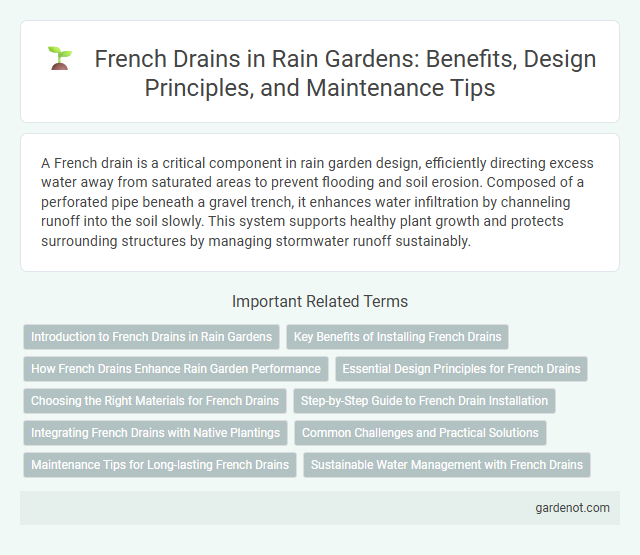A French drain is a critical component in rain garden design, efficiently directing excess water away from saturated areas to prevent flooding and soil erosion. Composed of a perforated pipe beneath a gravel trench, it enhances water infiltration by channeling runoff into the soil slowly. This system supports healthy plant growth and protects surrounding structures by managing stormwater runoff sustainably.
Introduction to French Drains in Rain Gardens
French drains in rain gardens serve as crucial subsurface drainage systems designed to redirect excess water away from saturated soil, preventing waterlogging and plant root damage. Composed of a perforated pipe surrounded by gravel, these drains enhance infiltration and improve water flow by channeling runoff to designated areas. Proper installation of French drains optimizes rain garden performance by maintaining soil moisture balance and reducing surface pooling during heavy rainfall events.
Key Benefits of Installing French Drains
French drains improve stormwater management by efficiently redirecting excess water away from foundations, reducing soil erosion and preventing basement flooding. Their permeable design promotes groundwater recharge while minimizing surface runoff, which helps protect landscape vegetation and reduces water pooling. Installing French drains also enhances property value by maintaining soil stability and preventing costly water damage repairs.
How French Drains Enhance Rain Garden Performance
French drains significantly enhance rain garden performance by efficiently directing excess water away from saturated soils, preventing waterlogging and promoting optimal plant growth. These subsurface drainage systems improve soil infiltration rates and reduce surface runoff, ensuring the rain garden effectively manages stormwater. Implementing French drains increases the longevity and functionality of rain gardens by maintaining balanced moisture levels and mitigating erosion.
Essential Design Principles for French Drains
French drains require a carefully graded trench filled with gravel and a perforated pipe to ensure proper water flow and prevent soil erosion. Effective waterproof fabric layering is essential to prevent sediment from clogging the drainage system while allowing water passage. Proper outlet placement at a lower elevation secures efficient water discharge, minimizing groundwater buildup and promoting sustainable rain garden performance.
Choosing the Right Materials for French Drains
Selecting the right materials for French drains involves using clean, washed gravel or crushed stone to promote efficient water flow and prevent clogging. High-quality perforated drainage pipes made of durable PVC or HDPE ensure long-term functionality and resistance to corrosion. Incorporating landscape fabric around the gravel layer helps filter sediment while maintaining proper drainage and soil stability.
Step-by-Step Guide to French Drain Installation
Excavating a trench approximately 18-24 inches deep and 12 inches wide is essential for French drain installation, ensuring proper water flow and drainage. Lining the trench with landscape fabric prevents soil infiltration and improves longevity, while placing perforated pipes on a bed of gravel facilitates efficient water collection and redirection. Backfilling with gravel followed by covering the fabric and soil creates a durable, effective drainage system ideal for rain garden setups.
Integrating French Drains with Native Plantings
Integrating French drains with native plantings enhances rain garden functionality by improving water infiltration and preventing soil erosion. Native plants, with deep root systems, complement French drains by naturally filtering runoff and stabilizing the soil around the drainage area. This combination maximizes stormwater management efficiency while promoting ecological balance and supporting local biodiversity.
Common Challenges and Practical Solutions
French drains in rain gardens often face common challenges such as clogging due to sediment buildup and improper slope design that hinders water flow. Practical solutions include installing a geotextile fabric filter to prevent soil intrusion and ensuring a consistent 1% to 2% slope to facilitate efficient drainage. Regular maintenance like flushing the drain and inspecting for blockages enhances long-term functionality and prevents water pooling.
Maintenance Tips for Long-lasting French Drains
Regularly inspect and clear debris from the French drain to prevent clogging and maintain optimal water flow. Ensure the gravel and filter fabric remain intact to facilitate efficient drainage and avoid soil infiltration. Perform routine checks after heavy rainfall to identify any pooling or erosion issues, addressing them promptly to extend the drain's lifespan.
Sustainable Water Management with French Drains
French drains effectively manage stormwater by channeling excess runoff away from landscapes and structures, reducing soil erosion and preventing waterlogging. Their gravel-filled trenches enhance groundwater recharge while filtering pollutants, supporting sustainable water management practices. Incorporating French drains into rain garden designs optimizes natural water infiltration and conserves local water resources.
French drain Infographic

 gardenot.com
gardenot.com